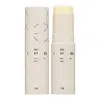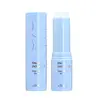What's inside
What's inside
 Key Ingredients
Key Ingredients

 Benefits
Benefits

 Concerns
Concerns

 Ingredients Side-by-side
Ingredients Side-by-side

Helianthus Annuus Seed Oil
EmollientPolyglyceryl-2 Triisostearate
EmulsifyingButyrospermum Parkii Butter
Skin ConditioningOctyldodecanol
EmollientPolyethylene
AbrasiveEuphorbia Cerifera Cera
AstringentMicrocrystalline Wax
Emulsion StabilisingDiisostearyl Malate
EmollientPrunus Amygdalus Dulcis Oil
Skin ConditioningTocopheryl Acetate
AntioxidantRicinus Communis Seed Oil
MaskingMonascus Extract
Skin ConditioningRoyal Jelly Extract
Skin ConditioningHoney Extract
HumectantPropolis Extract
Skin ConditioningBetula Alba Bark Extract
MaskingVitex Agnus-Castus Fruit Oil
MaskingCamellia Sinensis Seed Oil
HumectantCamellia Seed Oil
Argania Spinosa Kernel Oil
EmollientOlea Europaea Fruit Oil
MaskingSimmondsia Chinensis Seed Oil
EmollientSoluble Collagen
HumectantBisabolol
MaskingTocopherol
AntioxidantWater
Skin ConditioningButylene Glycol
HumectantCeramide NP
Skin ConditioningHyaluronic Acid
Humectant1,2-Hexanediol
Skin ConditioningGlycerin
HumectantSnail Secretion Filtrate
Skin ConditioningCaprylyl Glycol
EmollientAcetyl Hexapeptide-8
HumectantCopper Tripeptide-1
Skin ConditioningTripeptide-1
Skin ConditioningPalmitoyl Pentapeptide-4
Skin ConditioningHexapeptide-9
Skin ConditioningParfum
MaskingDehydroacetic Acid
PreservativeHelianthus Annuus Seed Oil, Polyglyceryl-2 Triisostearate, Butyrospermum Parkii Butter, Octyldodecanol, Polyethylene, Euphorbia Cerifera Cera, Microcrystalline Wax, Diisostearyl Malate, Prunus Amygdalus Dulcis Oil, Tocopheryl Acetate, Ricinus Communis Seed Oil, Monascus Extract, Royal Jelly Extract, Honey Extract, Propolis Extract, Betula Alba Bark Extract, Vitex Agnus-Castus Fruit Oil, Camellia Sinensis Seed Oil, Camellia Seed Oil, Argania Spinosa Kernel Oil, Olea Europaea Fruit Oil, Simmondsia Chinensis Seed Oil, Soluble Collagen, Bisabolol, Tocopherol, Water, Butylene Glycol, Ceramide NP, Hyaluronic Acid, 1,2-Hexanediol, Glycerin, Snail Secretion Filtrate, Caprylyl Glycol, Acetyl Hexapeptide-8, Copper Tripeptide-1, Tripeptide-1, Palmitoyl Pentapeptide-4, Hexapeptide-9, Parfum, Dehydroacetic Acid
Water
Skin ConditioningButylene Glycol
HumectantGlycerin
HumectantSodium Chloride
MaskingSodium Stearate
CleansingNiacinamide
SmoothingBis-PEG-18 Methyl Ether Dimethyl Silane
EmollientSnail Secretion Filtrate
Skin Conditioning1,2-Hexanediol
Skin ConditioningDisteareth-100 Ipdi
PEG-60 Hydrogenated Castor Oil
EmulsifyingSalicylic Acid
MaskingSodium Citrate
BufferingParfum
MaskingEthylhexylglycerin
Skin ConditioningAdenosine
Skin ConditioningDisodium EDTA
Ulmus Davidiana Root Extract
Skin ConditioningEthyl Hexanediol
SolventMenthyl Lactate
MaskingPropanediol
SolventGallyl Glucoside
AntioxidantAnhydroxylitol
HumectantCaprylic/Capric Triglyceride
MaskingXylitol
HumectantCentella Asiatica Extract
CleansingZingiber Officinale Root Extract
MaskingLoess Extract
Skin ConditioningMentha Piperita Leaf Extract
Skin ConditioningCamellia Seed Oil
Ceramide NP
Skin ConditioningAlcohol Denat.
AntimicrobialPropolis Extract
Skin ConditioningHydrogenated Lecithin
EmulsifyingGlucose
HumectantRoyal Jelly Extract
Skin ConditioningLeuconostoc Ferment Filtrate
AntimicrobialLinoleic Acid
CleansingSodium Hyaluronate
HumectantHoney Extract
HumectantPhenoxyethanol
PreservativeCarbomer
Emulsion StabilisingSr-Cat Polypeptide-1
Skin ProtectingHydrolyzed Collagen
EmollientWater, Butylene Glycol, Glycerin, Sodium Chloride, Sodium Stearate, Niacinamide, Bis-PEG-18 Methyl Ether Dimethyl Silane, Snail Secretion Filtrate, 1,2-Hexanediol, Disteareth-100 Ipdi, PEG-60 Hydrogenated Castor Oil, Salicylic Acid, Sodium Citrate, Parfum, Ethylhexylglycerin, Adenosine, Disodium EDTA, Ulmus Davidiana Root Extract, Ethyl Hexanediol, Menthyl Lactate, Propanediol, Gallyl Glucoside, Anhydroxylitol, Caprylic/Capric Triglyceride, Xylitol, Centella Asiatica Extract, Zingiber Officinale Root Extract, Loess Extract, Mentha Piperita Leaf Extract, Camellia Seed Oil, Ceramide NP, Alcohol Denat., Propolis Extract, Hydrogenated Lecithin, Glucose, Royal Jelly Extract, Leuconostoc Ferment Filtrate, Linoleic Acid, Sodium Hyaluronate, Honey Extract, Phenoxyethanol, Carbomer, Sr-Cat Polypeptide-1, Hydrolyzed Collagen
Ingredients Explained
These ingredients are found in both products.
Ingredients higher up in an ingredient list are typically present in a larger amount.
1,2-Hexanediol is a synthetic liquid and another multi-functional powerhouse.
It is a:
- Humectant, drawing moisture into the skin
- Emollient, helping to soften skin
- Solvent, dispersing and stabilizing formulas
- Preservative booster, enhancing the antimicrobial activity of other preservatives
Butylene Glycol (or BG) is used within cosmetic products for a few different reasons:
Overall, Butylene Glycol is a safe and well-rounded ingredient that works well with other ingredients.
Though this ingredient works well with most skin types, some people with sensitive skin may experience a reaction such as allergic rashes, closed comedones, or itchiness.
Learn more about Butylene GlycolCamellia Seed Oil is an oil and isn't fungal acne safe.
Ceramide NP is a type of ceramide and formally known as ceramide 3.
Ceramides are intercellular lipids naturally found in our skin that bonds dead skin cells together to create a barrier. They are known for their ability to hold water and thus are a great ingredient for dry skin.
Ceramides are an important building block for our skin barrier. A stronger barrier helps the skin look more firm and hydrated. By bolstering the skin ceramides act as a barrier against irritating ingredients. This can help with inflammation as well.
If you would like to eat ceramides, sweet potatoes contain a small amount.
Read more about other common types of ceramides here:
Ceramide AP
Ceramide EOP
Glycerin is already naturally found in your skin. It helps moisturize and protect your skin.
A study from 2016 found glycerin to be more effective as a humectant than AHAs and hyaluronic acid.
As a humectant, it helps the skin stay hydrated by pulling moisture to your skin. The low molecular weight of glycerin allows it to pull moisture into the deeper layers of your skin.
Hydrated skin improves your skin barrier; Your skin barrier helps protect against irritants and bacteria.
Glycerin has also been found to have antimicrobial and antiviral properties. Due to these properties, glycerin is often used in wound and burn treatments.
In cosmetics, glycerin is usually derived from plants such as soybean or palm. However, it can also be sourced from animals, such as tallow or animal fat.
This ingredient is organic, colorless, odorless, and non-toxic.
Glycerin is the name for this ingredient in American English. British English uses Glycerol/Glycerine.
Learn more about GlycerinThis ingredient comes from honey made by bees. It is hydrating, antibacterial, anti-aging, and skin soothing.
Honey also contains amino acids, peptides, Vitamins A, C, and E.
The humectant property of honey draws moisture from the air to your skin. This makes it great at helping to hydrate the skin.
Honey may help reduce the signs of aging due to its antioxidant properties. Fun fact: darker honey has more antioxidants than light honey. The antibacterial property of honey may make it effective at helping to treat acne by killing acne-causing bacteria.
Many people wonder if honey extract is vegan. It is technically a byproduct from bees. This is because honey is created from the digestive enzymes in a bee's stomach.
Remember to be kind to bees :) They are important for many ecosystems and are endangered.
Learn more about Honey ExtractParfum is a catch-all term for an ingredient or more that is used to give a scent to products.
Also called "fragrance", this ingredient can be a blend of hundreds of chemicals or plant oils. This means every product with "fragrance" or "parfum" in the ingredients list is a different mixture.
For instance, Habanolide is a proprietary trade name for a specific aroma chemical. When used as a fragrance ingredient in cosmetics, most aroma chemicals fall under the broad labeling category of “FRAGRANCE” or “PARFUM” according to EU and US regulations.
The term 'parfum' or 'fragrance' is not regulated in many countries. In many cases, it is up to the brand to define this term.
For instance, many brands choose to label themselves as "fragrance-free" because they are not using synthetic fragrances. However, their products may still contain ingredients such as essential oils that are considered a fragrance by INCI standards.
One example is Calendula flower extract. Calendula is an essential oil that still imparts a scent or 'fragrance'.
Depending on the blend, the ingredients in the mixture can cause allergies and sensitivities on the skin. Some ingredients that are known EU allergens include linalool and citronellol.
Parfum can also be used to mask or cover an unpleasant scent.
The bottom line is: not all fragrances/parfum/ingredients are created equally. If you are worried about fragrances, we recommend taking a closer look at an ingredient. And of course, we always recommend speaking with a professional.
Learn more about ParfumPropolis Extract is also known as bee glue.
This ingredient has antimicrobial, anti-inflammatory, wound healing, and antioxidant properties.
Studies show propolis helps fight against bacteria, viruses, and fungi. This may help with reducing acne and accelerate wound healing.
The flavonoids found in propolis extract are potent antioxidants. Antioxidants may help with reducing the signs of aging.
A study from 2020 found propolis to help reverse skin damage from UV.
Fun facts: This ingredient is created by mixing beeswax, bee saliva, and parts of trees. Bees use propolis as a sealant to close any gaps in their hives.
Since it is an animal-derived product, this ingredient is not considered vegan. For vegan alternatives, check out Galactomyces Ferment Filtrate or Centella Asiatica Extract.
Learn more about Propolis ExtractRoyal Jelly Extract comes from a secretion made by worker honeybees. This secretion is white and described as creamy.
This compound has antibacterial, anti-aging, and anti-inflammatory properties.
Studies show Royal Jelly to contain amino acids, fatty acids, and a variety of vitamins, including Vitamin Bs. Many of these components are antioxidants, which help with anti-aging. The fatty acids in Royal Jelly make it a hydrating ingredient.
Several animal studies show Royal Jelly to boost collagen production and reduce inflammation.
The Vitamin Bs found in Royal Jelly include:
Royal Jelly is derived from honeybees. This means it is not vegan.
Learn more about Royal Jelly ExtractSnail Secretion Filtrate is the excretion from snails. It is an effective moisturizer and promotes collagen production.
A popular nickname for this ingredient is 'Snail Mucin'.
Snail mucin has numerous skin benefits:
On top of this, Snail Secretion Filtrate contains a variety of vitamins and minerals. These include copper peptides, Vitamin A, and vitamin E. Vitamins A and E are antioxidants. Antioxidants help fight free-radicals that damage skin cells.
Being cruelty-free means a brand does not experiment on animals.
If you're worried about the well-being of the snails, we recommend looking more into the company of the product. Many brands have developed humane methods to collect snail mucin.
There is much debate on this subject. On one hand, this ingredient comes from an animal. On the other hand, many will argue the ingredient is naturally secreted (like a natural by-product) and therefore vegan. If you have reservations, you can look into Galactomyces Ferment Filtrate or Centella Asiatica Extract as alternatives.
Learn more about Snail Secretion FiltrateWater. It's the most common cosmetic ingredient of all. You'll usually see it at the top of ingredient lists, meaning that it makes up the largest part of the product.
So why is it so popular? Water most often acts as a solvent - this means that it helps dissolve other ingredients into the formulation.
You'll also recognize water as that liquid we all need to stay alive. If you see this, drink a glass of water. Stay hydrated!
Learn more about Water